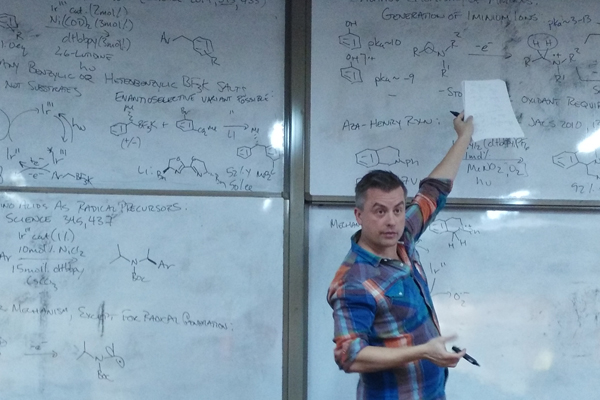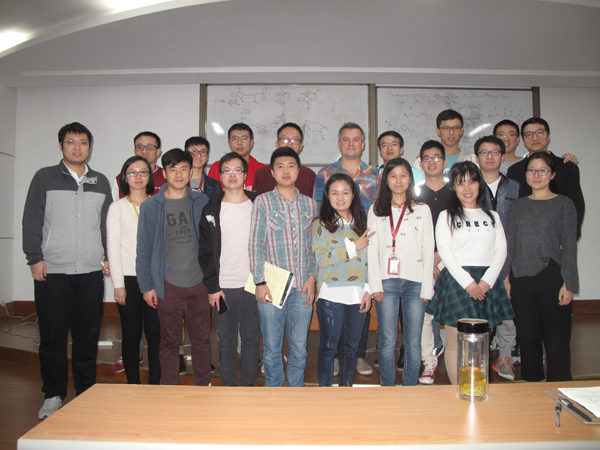From Dec. 19th to 23th, 2016, with the invitation of Prof. Yong Huang, Prof. David Nicewicz visited our school and gave a short course titled “Modern Methods in Radical Chemistry”, which possessing rich content and attracting teachers and students from our school and Tsinghua University to participate.
In the first part of this course, Prof. Nicewicz introduced this course from background of radical chemistry, which containing physical organic chemistry, photochemistry and electrochemistry. During the humorous and fascinating course of Prof. Nicewicz, students learned many fundamental chemical/physical concepts and its recent applications on radical chemistry, which arranging from classical Marcus Theory to frontier researches on Dynamics of Electron Transfer, from Jablonski Diagram to Donor-Acceptor Absorption Complexes, and from Basics of Electrochemistry to its application on Mechanistic Investigation of Photochemistry.
Upon students getting deeper understanding on the fundamentals of radical chemistry, Prof. Nicewicz presented numerous organic synthetic applications emerging in photochemistry via powerful active intermediates, neutral radicals or radical anions, comprehensively.
With further understanding of photoredox catalysis during the last decade, chemists now can utilize radicals, which generating by reducing of alkyl halides, reductive decarboxylation of activated esters, oxidative decarboxylation of carboxylates, oxidizing of oxalate salts, in-situ oxidizing of alcohol derivatives, reducing of aryl diazonium salts, hydrogen abstracting by hydrogen-transfer co-catalysts, reducing of enones, oxidizing of amines and so on, to realize many challenging chemical transformations, which classified as photocatalyzed F-C type arylation, amination, trifluoromethylation and alkylation of arenes or hetero arenes; photocatalyzed α-functionalization via oxidation of amines; photocatalyzed cross-coupling reactions; asymmetric α-alkylation, trifluoromethylation, benzylation of aldehydes using chiral amines and Ru/Ir complexes via synergistic catalysis; asymmetric [2+2] cycloadditions using chiral lewis acid Eu and Ru photocatalyst via cooperative catalysis; chiral phosphoric acid inducing asymmetric reductive cyclizations; and chiral ligand harnessing asymmetric desilylation Michael reaction by oxidation of amines using Ru photocatalyst and lewis acid Sc.
During this 5 days’ short course, teachers and students of our school discussed academics and exchanged ideas with Prof. Nicewicz actively, and all of us wished that Prof. Nicewicz, Pengcheng Professor of Chemistry of our school, would return to SCBB as soon as possible and give us more lectures. ( Written by Xin-Hang Jiang )


Introduction of Prof. David Nicewicz
David Nicewicz was born and raised in central New Jersey. He completed his B.S. (2000) and M.S. (2001) in Chemistry at the University of North Carolina at Charlotte under the direction of Craig Ogle. Dave then went on to the University of North Carolina at Chapel Hill, where he did his Ph.D. studies under the tutelage of Jeffrey Johnson. Under Jeff’s direction, Dave investigated the use of the Brook rearrangement in synthetic methodology and its application to the total synthesis of zaragozic acid C. Upon completion of his Ph.D. studies in 2006, Dave returned to his native New Jersey where he was a Ruth L. Kirschstein National Institutes of Health Postdoctoral Researcher in the laboratories of Professor David MacMillan at Princeton University. While in MacMillan’s lab, Dave helped develop the budding area of photoredox organocatalysis. In July of 2009, Dave returned to UNC as an Assistant Professor of Chemistry, and in 2015, Dave got tenure as an Associate Professor of Chemistry in UNC.